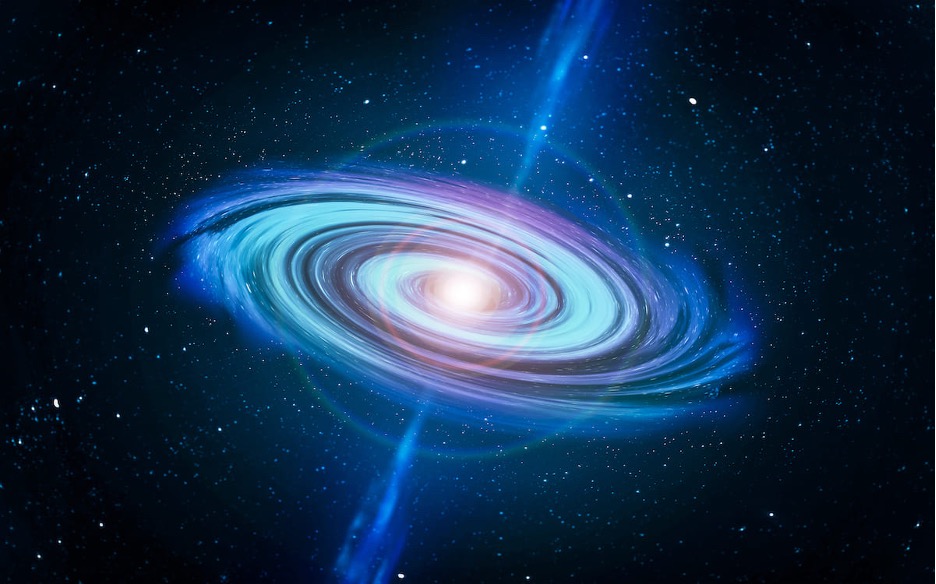The antipode of black hole: Is there a white hole in space?
19th Dec 2022
Space never ceased to attract humanity, giving rise to new hypotheses about the origin and structure of our Universe, feeding our desire to know what exists beyond Earth — including exploring a relatively new hypothesis of white holes’ existence. Just think about the scale of space. Over the centuries, astronomers have managed to discover only 4% of all stars, planets and galaxies, while the rest of the objects remain a mystery. And one of these mysteries, according to scientists, might be the existence of a white hole.
In this article, we will try to figure out what a white hole actually is, whether this phenomenon really exists, and how it differs from a black hole.
What is a white hole?
Simply put, a white hole is an antipode of a black hole. Scientists started talking about the existence of black holes at the beginning of the last century, with the appearance of Einstein’s first works on the theory of relativity. Theoretical astrophysicist Igor Novikov first proposed the possibility of white areas’ existence in 1964. The scientist was guided by the fact that if there is a region with specific characteristics in the Universe, there must also be a region that is entirely opposite to it.
A black hole is a region of outer space that has a colossal gravitational pull. Any objects, even those that have the highest speed, comparable to the speed of light, when they enter the event horizon of a black hole, are drawn in and never come back. Nothing can resist this gravitational pull.
Based on this, we can assume that there is an area that, on the contrary, does not let anything in but pushes it out instead. That is, just as nothing can escape a black hole’s event horizon, nothing can enter a white one’s event horizon.
So, does a white hole exist?
There is still no proof of white holes. So far, this is just a theoretical concept that has never been observed in the Universe. That is why most scientists believe that they simply do not exist, and most discussions on this topic remain “hypothetical”, “impossible”, and “unrealistic”. But let’s consider the possibility that they do exist.
What can create a white hole: 4 hypotheses
1. The Big Bang
There are several theories on how a white hole is formed. One of them is that the Big Bang was a white hole. According to Einstein’s gravitational theory, the Universe could be an interior of a black hole formed as a result of the Big Bang. Later, scientists made an assumption that the Big Bang itself could be regarded as a white hole because a huge mass of matter was thrown out by one impulse.
2. Event horizon
Igor Novikov, and later Stephen Hawking, believed that white holes could be formed when the matter of a black one exits the event horizon, which is in the opposite direction of the thermodynamic arrow of time. In their opinion, a space-time map cannot contain only a black or only a white area; instead, both a black and a white one are necessarily present.
3. Another Universe
According to Kerr’s solution, a white hole is formed in another universe at the exit of a black hole. An all-consuming black hole has the opposite end — an exit and this exit can be a white area, but it is located in another Universe, in the past time, while the Universe with a black area is perceived as the future.
4. Stars collision
Israeli scientists Alon Retter and Shlomo Heller admit that white holes appear in outer space spontaneously and repeatedly as the result of the collision between two stars. In a few seconds, they eject all of their matter and disappear right after. In their place, a black hole appears instead. It is impossible to predict when such a phenomenon will occur, just as one cannot call a white hole a cosmic body.
The basis for the reasoning was the gamma-ray burst GRB 060614, which occurred in 2006 in the constellation Indus at a distance of more than one and a half million light-years from Earth. The recorded flash lasted 102 seconds, which should have meant that it would end in a supernova explosion. But scientists found no supernova that would be associated with GRB 060614. Besides, no gamma-ray bursts or new object appearances were expected in this area of the sky at all, so Retter and Heller, together with their colleagues, called the 2006 flare the Small Bang. However, this is still not enough to state that a white hole was discovered.
However, researchers are confident that such bursts are, in fact, white holes — they frequently occur throughout the Universe, but due to the distance of several light years, we cannot observe them. And it’s good because such a consequential ejection of matter would probably destroy life on Earth.
Can you exit a white hole?
No. Since this is an area with dense matter and a buoyant force, no object can enter it; therefore, there is nothing to make an exit. So, the answer to the question of what happens if you enter a white hole becomes obvious: nothing happens because no one can enter it under any circumstances.
Moreover, it is possible that the repulsive force will throw any approaching object to an indefinite distance, significantly changing its flight path. This potentially answers another common question — Does a white hole push you away? Yes, and with enormous power.
What happens if a black hole hits a white hole?
The black hole vs a white hole scenario will depend on both their size and their repulsive/attractive force strength. Assuming that these forces are equivalent, the regions can move apart and continue to exist separately.
If the black hole’s attraction force is greater than the white hole’s repulsion force, then presumably, the black hole will swallow the white one. The mass repelled by the white space will be absorbed by the black hole, serving as the source of energy for it. Scientists think that the absorption process can be very slow and may take over several thousand years.
Would a white hole beat a black hole?
There is no scientific reason to believe that a white hole can beat a black one. Black holes, as far as we know today, are very curved spaces that absorb everything and from which there is no exit.
When absorbing matter pushed out by the white hole, the black hole increases in size and becomes more powerful, while the white hole gradually diminishes. As a result, the black hole completely absorbs the white one. What would a white hole’s victory over a black one look like? By all assumptions, its repulsive force cannot have a destructive effect on an area with stronger attraction.
According to scientists, a black hole that absorbs a white one could grow to a size 3 million times greater than the size of Earth. Such a phenomenon would be very dangerous in the Universe, since a huge funnel would absorb everything that comes in its way.
Of course, since the existence of cosmic white area has not been proven, all this reasoning is purely hypothetical.
Summing it up
So, what is a white hole? Dense matter with buoyant force, the opposite edge of a black hole escaping into the past, or a star explosion forming a black hole? There is no definite answer. No one has seen it yet, but the theory of its existence seems fascinating and inspires further research. And when humanity becomes more technologically advanced to penetrate deeper into space, we may find an answer to the white hole puzzle.




Thank you for your comment! It will be visible on the site after moderation.